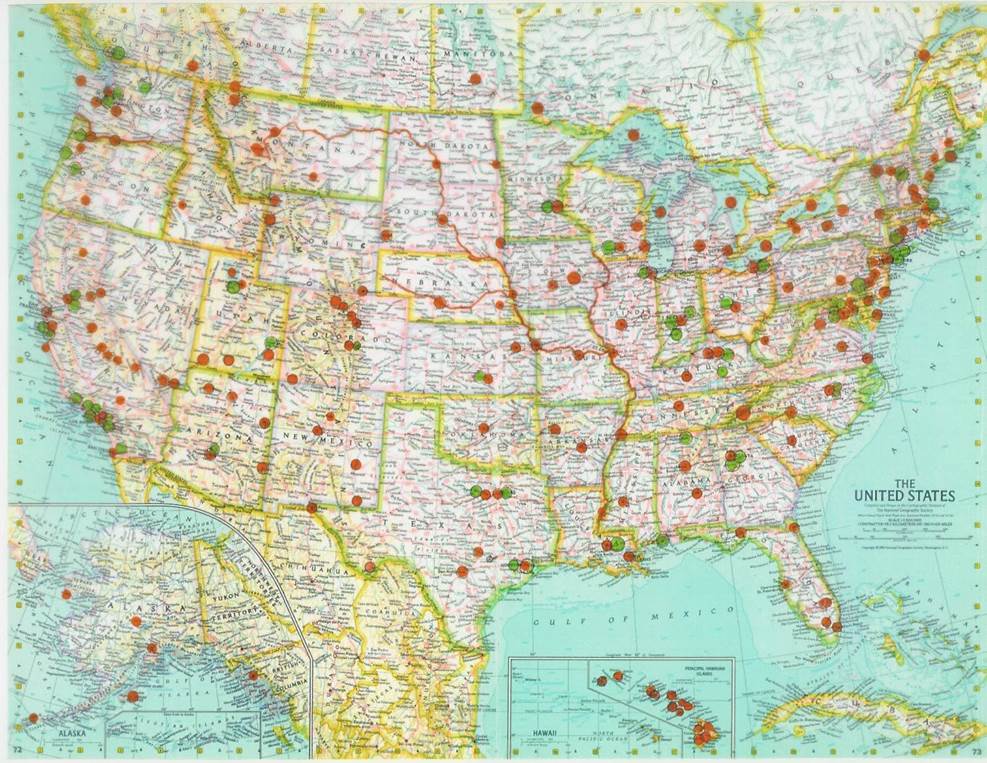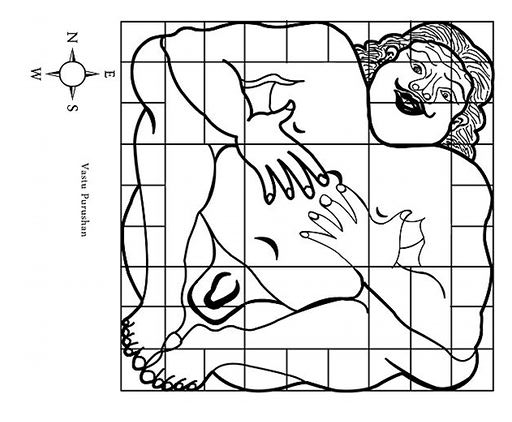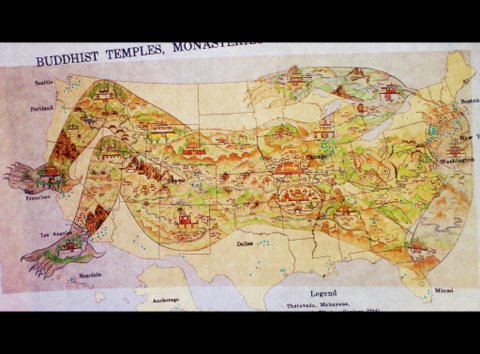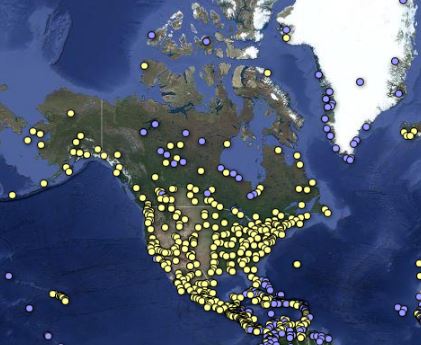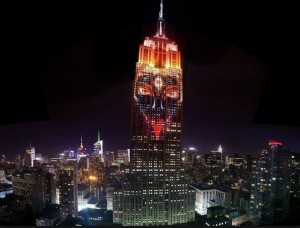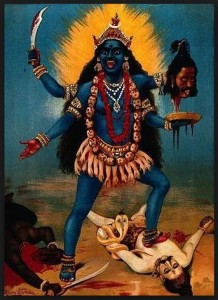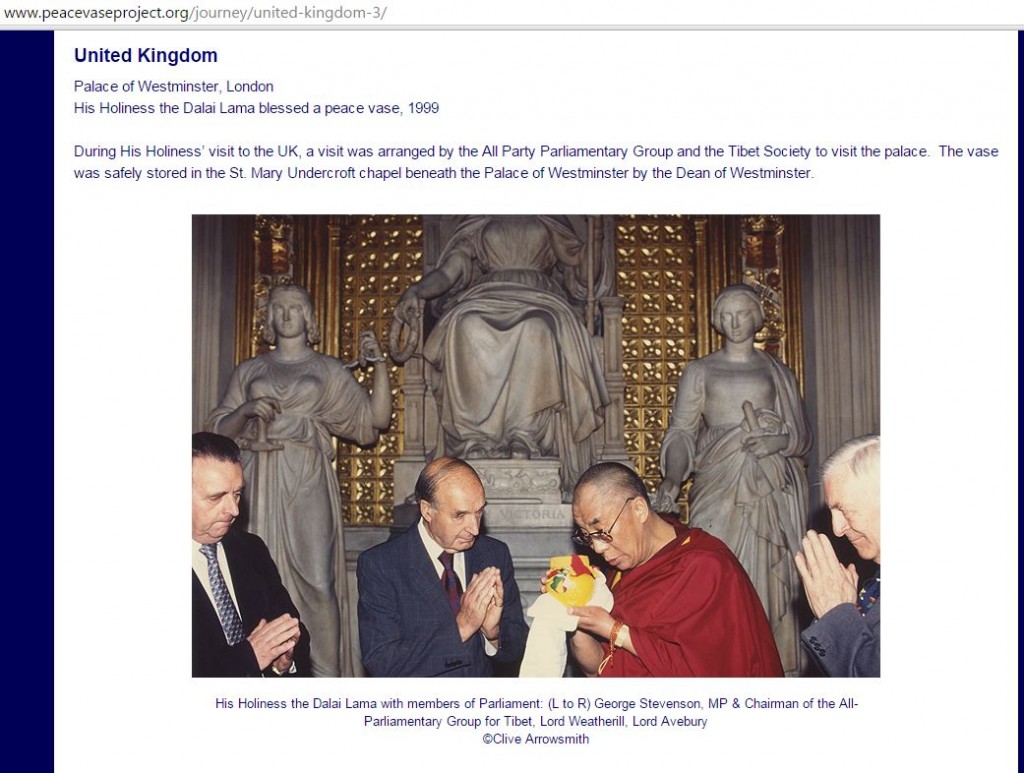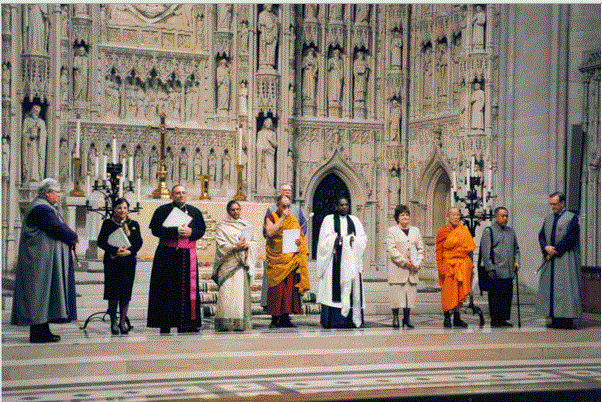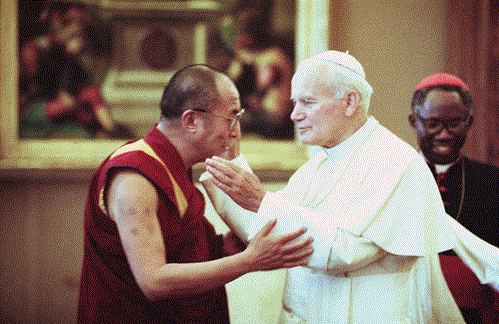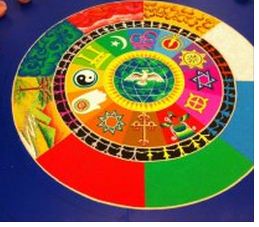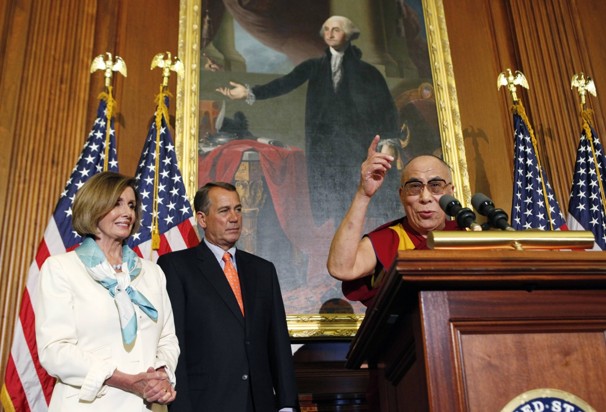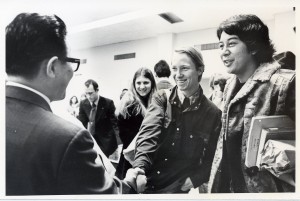The Dalai Lama and the Anatomy of
Politically Correct Buddhism
By James C. Stephens
But what conception of the world is hiding behind the smiling, so apparently philanthropic and peaceable mask of the Tibetan God-King? The ignorance that this key question exposes, particularly in the western world, can only be described as catastrophic. (Neue Zurcher Zeitung July 15, 1999 A German Newspaper)
Nearly three thousand tickets for the Annual “Distinguished Speaker’s Series” at the Pasadena Civic Auditorium featuring the Dalai Lama had sold out within an hour. Since no seats were available, I decided in Jay Leno fashion to go down and conduct some on the street interviews of people waiting to get a glimpse of the God-King of Tibet.
As that balmy October Southern California evening arrived, the air was filled with the anticipation of an opening night in Hollywood. Black limousines carrying the Dalai Lama and his US Diplomatic Secret Service escort pulled up to the Mediterranean style auditorium. A smattering of celebrities and Tibetan lamas with shaved heads dressed in maroon robes trimmed in golden yellow mingled in the large crowd lined up to pass through the specially installed security stations.
I was standing near “Heather” a slender hippyish woman in her twenties who was observing that evening’s crowd and occasionally seeing if a passerby had any extra tickets. Nonchalantly I asked her, “So, what brings you out here this evening?”
She replied, “Oh, I hitch hiked out here this summer from the Ozarks with my boyfriend to attend the Empowerment Ceremonies with the Dalai Lama. Tonight we decided to see if we could attend his public talk on Ethics for the New Millennium.”
“Will you be disappointed if you can’t get in?” I inquired.
Without hesitation she mused, “Not really. I’ve been watching all the well-dressed people going in and decided they probably need to hear him more than I do.”
Since she was open I posed a slightly more personal question, “Hypothetically, let’s say that Jesus Christ and the Dalai Lama were to be standing here before you and you had the opportunity to choose one to follow. Who would you select?”
She paused for a moment and then said, “The Dalai Lama.” Observing my slightly baffled look, she confessed, “Well, he is the spiritual leader of our day who’s bringing everyone together. He seems to fit our times better, and although I find Jesus attractive, I don’t feel the same about most Christians.”
When asked why the Dalai Lama was so popular, she commented, “I think he is like the Wizard of Oz, reflecting people’s illusions of what they want to believe.”
At first I was taken aback, but recognized that her comments represent a growing segment of our society that wholeheartedly embraces Buddhism as their religion of choice and leaving no doubt that the Lotus is blooming in America. Studies have shown that there are presently over 1600 Buddhist temples, centers and monasteries in America, many of them Tibetan. [1] In the twelve years between 1985 and 1997, “more Buddhist meditation centers were established than the total number founded in the first eighty-five years of the twentieth century.” [i]
Currently Buddhism is being marketed to such a high degree that even Buddhists parody the Madison Avenue hype surrounding the Buddhist boom. Buddha books are big business, while magazines are a lucrative cottage industry supported by pages and pages of advertisements marketing everything from retreats, national conferences, the reincarnation of tea, salad dressings, Buddha beads, sneakers to smiling Tibetan lamas opening Toshiba laptops on the “rooftop of the world.” Huge billboards along LA freeways featured the smiling image of the Dalai Lama advertising Apple’s “Think Different,” while the “Simpson’s,” a primetime cartoon program parodying American culture focused on little Lisa’s conversion to Tibetan Buddhism on their Christmas special.
As a college student who had converted to Buddhism in 1970, like Heather, I had been enamored with the exotic religious rituals, smells of incense, chants, and ancient stories of Buddha’s life and teachings. Myths like the life of the Buddha convey powerful images to believer and non-believer alike. Ignoring those myths in global affairs can bring dire consequences, e.g., Wahabism, the radical fundamentalist Islam of Osama Bin Laden. Approaching a worldview different from our own requires freedom to think critically and a “civil public square” [ii] that embraces discussion and debate, essential components for the survival of the human race. In certain Buddhist countries, nationalism is equated with religious expression, e.g., “To be Thai is to be Buddhist, to be Buddhist Thai.” The same holds true in Tibet and other Buddhist nations where there is no separation of Church and State and constitutionally Kings are required to be Buddhist.
Doctrine of Assimilation. Over the last 2500 years, the Buddhist faith has developed a highly sophisticated process of expansion and of contextualizing its religious message. The historic doctrine of assimilation (honji-suijaku) allows Buddhism to compete with the highly established indigenous religions in countries as it attempts to take root.
Its first approach is to the indigenous host culture. As Buddhism took hold in China, which at the time was primarily Confucian and Taoist, this took the form of introducing the Buddhist law (Dharma). The next time-consuming step over a period of eighty years involved the translation of their scriptures into the language of the host country. For the West, this occurred during the pinnacle of the British Empire as Rhys Davids, Max Müller, Daniel Gogerley, and a host of scholars belonging to the Pali Text Society translated numerous Buddhist texts which were incorporated into the voluminous Sacred Books of the East and brought Buddhism to the attention of English speaking audiences worldwide.
During the third step of the process, Buddhists seek out the areas of commonality with the host culture’s faith, thereby appearing to have much in common with their own religion. [iii] In the West, we now find a plethora of books written in this genre by Buddhist teachers, e.g., The Good Heart: A Buddhist Perspective on the Teachings of Jesus by the Dalai Lama, Living Buddha, Living Christ by Thich Nhat Hanh, or The Zen Teachings of Jesus by Kenneth S. Leong.
A careful reading of the Dalai Lama’s book Ethics for the New Millennium bears little resemblance at all to a traditional view of Buddhist ethics. His “consensus ethics” represents the assimilation of a variety of different religious viewpoints which don’t require a person to be a member of any religion. Like a chameleon this enables the Dalai Lama to blend into many different religious settings, granting him access to an enormous secular audience yearning for spiritual answers.
Historical Cause for Concern. The Office of the Dalai Lama has systematically developed the doctrine of “skillful means” (upayakaushalya) over 1300 years. Tibet, as an isolated and sparsely populated country with a weak standing army, is strategically located between four historical military giants, China, Mongolia, Russia, and India. Consequently, it has had to rely upon its religious and political prowess to survive.
Historically, Tibet was not always Buddhist. Tibetans in fact were followers of Bön (pronounced “pern”), an indigenous faith which centered on Shamans who worshipped fierce mountain gods and other demonic spirits. [iv] In 642 A.D. the Tibetan King Srong-btsan-sgampo granted his Chinese and Nepalese wives’ wish to introduce Buddhism.
A little over a hundred years later in 745 A.D., an Indian Tantric Buddhist Padmasambhava made a journey to Tibet and taught that humans could reach enlightenment in one lifetime. At the request of the Tibetan Buddhist King Detsan, he “waged war against and conquered all the malignant gods in Tibet, only sparing those that promised to become Defenders of the Law (Dharmapala).” Padmasambhava introduced the systematic practice of theTantras [2] to Tibetans which involved the use of spells (mantras [3]), circles of deities arranged in sand paintings (mandalas), symbolic sexual union with deities (deity yoga), occult hand gestures (mudras) and magic. [v]
Co-opting control of Tibet from the Bön rulers was accomplished through power encounters with the local gods. One researcher found actual drawings and discovered that when Buddhists originally tried to establish their authority over Tibet’s Bön kingdom by building an altar on the capital’s grounds, it was always torn down.
Frustrated by their lack of success, they consulted their oracles who instructed them on how to secure that authority. They were instructed to locate spiritual power points throughout the nation and then to build altars and make offerings to local topographical gods on mountain peaks, valleys, rivers and lakes. After the Buddhists completed their assignment they noticed that the points on the national map took the form of a demoness who was “nailed down.” They were then able to establish authority over the national capital and build the Jokhang Temple located at the “heart of the woman.” [vi]Consequently, some Buddhologists speculate that Tibetan Buddhism is founded upon the symbolic subjugation of a woman nailed down and metaphysically alive at the bottom of the lake near the Johkang. This is in Lhasa, the ‘city of the gods’, the capital of Tibet, and the former residence of the Dalai Lama, the Potala Palace.
Later, as the Moslem invaders were destroying Buddhism in Northern India, the Mongols were led by Genghiz Khan in 1206 in a war to establish his kingdom across China and Mongolia. The Tibetan lamas seized this opportunity to convert the notorious Khan to Tibetan Buddhism prior to his becoming the Emperor of China. This symbiotic relationship of patron-priest served them both well as the Tibetan Grand Lama became a vassal-ruler of Tibet and spiritual advisor to the Emperor.
Because of the corruption of the Tibetan monastic centers, a reform movement arose called the “dGe-lugs-pa“(pronounced Gelak) literally the “Model of Virtue” recognized by their “yellow hats.” This is the school of Tibetan Buddhism led by the Dalai Lama. Their school focuses upon the serious study of Tantric texts such as the Kalachakra [4] Tantra which forms the foundation of their national myth. [vii]
A key component of their religious agenda is the establishment of Shambhala, a global Buddhist empire, illuminated in the Kalachakra initiation. While researching the life of Agvan Dorzhiev, tutor to the XIII Dalai Lama and Lhasa’s emissary to Russia’s Tsar, John Snelling uncovered the “ShambhalaProject,” Dorzhiev’s vision of a great Buddhist empire. “Many Kalachakra devotees, including the present Dalai Lama believe that it is an actual place.”[viii] Dorzhiev “skillfully” negotiated the political support of the Bolshevik regime in his religious vision by stating that “Buddhist doctrine is largely compatible with current Communist thinking.” [ix]
The “Shambhala Project” incorporated Geshe Wangyal, a key Tibetan Buddhist leader from Kalmykia (a Tibetan Buddhist Republic in the former USSR). Fleeing the “full brunt of Stalin’s wrath” in 1952, Kalmyk refugees were the first group of Tibetan Buddhists to see Lady Liberty. After resettling in New Jersey, they established a Tibetan Buddhist temple and “in 1955, the eminent Kalmyk Lama Geshe Wangyal (1901-83) came to minister there.[x]
Who is the Dalai Lama and What Does He Believe? The term Dalai Lama describes the Office of God-King of Tibet (not unlike the term Pope of Roman Catholicism) and literally means “Ocean of Wisdom.” It was first ascribed to Sonam Gyatso (1543) the Gelak Buddhist reformer by Altan Khan, the leader of Mongolia. Tibetan followers refer to him by the title “Kundun” meaning “the Presence.”
The phrase “the Lama knows” is commonly heard throughout all strata of Tibet’s priest dominated society. Its’ early kings established the divine right of priest-kings and enforced “absolute submission to a religiously charismatic individual.” [xi] For the laity, it is impossible to achieve enlightenment without the instruction of a private lama (guru). From childhood Tibetans are taught to worship the Four Jewels paying; “homage first to the Lama (spiritual master), then to the Buddha, Dharma (Law of Buddhism), and Sangha (priestly community).” [xii]
Reincarnation or Patisandhi (lit. Reunion, Relinking) is a foundational belief of Tibetan Buddhism, wherein an individual’s consciousness or mind is reborn lifetime after lifetime based upon the karmic conditions of their previous existence. Karma is the sum total of “the wholesome or unwholesome actions by body (kaya-kamma), speech (vaci-kamma) and mind (mano-kamma)” which will determine when, where and what form you will be born into, be it a peacock, snake, elephant, or king.
In each lamasery (monastery) approximately 30 lamas are accorded the rank of “noble monks” resulting from their recognition as reincarnations of previous lamas. One such story involves a young boy named Lhamo Thondup who was born in 1935 during the year of the Wood Hog in a small village in northeast Tibet. A group of Tibetan lamas disguised as merchants were led to his household by “a series of signs and visions” in their search for the new reincarnation of the recently deceased thirteenth Dalai Lama.
At the age of three, little Thondup took “hold of the prayer beads around the “servant’s” neck, which had belonged to the 13th Dalai Lama,” and demanded “to be given them saying they were his.” [xiii] These signs along with a physical examination, led the lamas to believe he was indeed the 14th Dalai Lama, considered to be an incarnation of Avalokitsevara, the patron deity of Tibet believed to be able to save all living beings. To obtain his release they paid a large ransom demanded by the local Muslim Governor.
At the age of five he was enthroned in Tibet’s Potala Palace, taken to the Jokhang Temple for ordination, had his head shaved and was renamed “Tenzin Gyatso.” For the next eight years his tutors trained him in the monastic curriculum and the art of leading a nation. He was also schooled in theoccult praxis of Tibetan Buddhism based upon ritualistic chanting of sutras and the magical incantation of Om mani padme hum.
Unlike salvation within Christianity wherein an individual relies upon the unmerited favor of God and through faith personally accepts Christ’s finished work of redemption on the Cross, the religion of Tibetan Buddhism is based upon a rigorous system of works righteousness through which an individual accumulates enough merit to achieve deliverance from the wheel of Samsara or cycle of rebirths. These works primarily include the redundant recitation of incantations (mantras and sutras), proscribed religious rites and an assortment of mechanistic practices utilizing Buddhist rosary beads, prayer wheels, prayer flags, mani stones, visualization of demonic entities and symbolic offerings.
Those disciples who are on a fast track to enlightenment would include attendance of their guru’s empowerment ceremonies, performance of Tantric rituals, deity yoga (being spiritually yoked to Tibetan gods) and other acts, some of which are too vile to mention. Herein, they perform rigorous acts of asceticism which deny the contemptible flesh, whereby they hope to make significant merit to attain the short path of liberation and attain nirvana, “the ultimate and absolute deliverance from all future rebirth, old age, disease and death, from all suffering and misery.”
The Public Relations Department. How is it that wherever the Dalai Lama ventures, that the seemingly Teflon mystique of “Shangri-La” follows him? Originally the myth seems to have found its voice through the writings of James Hilton, the author of Lost Horizons and Lowell Thomas’s radio programs about his adventures in Tibet. [xiv] Movie Director, Frank Capra perpetuated the myth of “Shangri-La,” a mysterious hidden kingdom through “Lost Horizons” (1937).
Rarely though does the Dalai Lama speak of his country’s historical problems with feudalism or his political contacts with Neo-Socialists. In Tricycle, a quarterly Buddhist magazine, Alex McKay explores the Nazi expedition to Tibet in 1939 involving five members of Hitler’s Secret Service. Their anthropological studies sought to confirm evidence of Hitler’s “idea of racial perfection that would justify their views on world history and German supremacy.” [xv] This became a source of embarrassment to the producers of “Seven Years in Tibet” which quickly glossed over Heinrech Harrer’s SS connection to Adolf Hitler.
Dr. Erwin Lutzer, pastor of Moody Bible Church in Chicago, shared his concern about Tibet’s connection with Nazi Germany in Hitler’s Cross, a startling expose. He wrote,
Karl Haushofer became Hitler’s mentor. Haushofer had made several trips to India and was well versed in eastern occultism. He also lived in Japan for a time where he was initiated into an esoteric Buddhist sect called the “Green Dragon.” Through these contacts a colony of Tibetan lamas settled in Berlin, and when the Russians took the city in 1945, they found a thousand Tibetan corpses in German uniforms. Haushofer, more than any other, challenged Hitler with the vision of world conquest. [xvi]
The newer contacts of the Dalai Lama with Neo-Nazis are equally troubling. On several occasions he has met with Chilean diplomat Miguel Serrano, the leader of the National Socialist Party of Chile who is the “ideologist of esoteric Hitlerism.” Serrano was a student of ‘Julius Evola (1898-1974) WWII Italian Fascist dictator Benito Mussolini’s chief ideologist, who was heavily influenced by Tibetan Tantricism.’ [xvii]
The remarkable tenure of the Dalai Lama as God-King for life surpasses every President we’ve had since Franklin D. Roosevelt. Although most nations do not officially recognize Tibet as a sovereign nation, they still allow the Dalai Lama the liberty to speak from his platform as a religious leader, even though they have little knowledge of Tibetan Buddhism’s global agenda or its worldview. As a religious and political foreign guest, the Dalai Lama has mastered the Buddhist art of “skillful means” (Upaya) and utilizes his position to propagate Tibetan Buddhism believing “the end, justifies the means.”
In October 1950, “his age of innocence was swept away as eighty thousand (Chinese) soldiers marched into Chamdo and started the “peaceful liberation” of Tibet.” [xviii]
Commencing at fifteen the Dalai Lama formally assumed the reign of authority as the temporal and spiritual ruler of Tibet and directly dealt with the Chinese occupation until his escape in March 1959. Moment’s before leaving, the Dalai Lama presented a long silk scarf to his personal protector deity,Mahakala. [5] He later commented, “This is the traditional Tibetan gesture on departure and signifies not only propitiation, but also implies the intention of return.”
The US political ties with the Dalai Lama extend back to the CIA’s secret operations as overseen by President’s Eisenhower, Kennedy and Johnson. [xix]In 1956, the US government secretly trained 300 Tibetan Khamba warriors in Colorado’s Winter Training camp to assist the Dalai Lama, who later “thanked the CIA for organizing some of the guerrillas who protected him during his flight into Indian exile in 1959.” [xx]
How did the Dalai Lama rise to such a high level of international recognition? After his escape, he spent much time concentrating on establishing the Tibetan government-in-exile in Dharamsala, India and encouraging Tibetans to engage in non-violent opposition to the Communist occupation of Tibet. Subsequent travels to Japan and Thailand in 1967 cemented his ties with Asian Buddhists.
In 1973, his first exposure to the West focused on visits to the Tibetan Diaspora in Switzerland and a meeting with Pope Paul IV. His biggest shock came when he found that the next generation of Swiss Tibetans could not speak Tibetan. Upon his 1979 arrival in the United States, the New York Timesheadline greeted him with the now abused greeting, “Hello Dalai!”
During his second journey to the US in July 1981, the Dalai Lama conducted the first Kalachakra Initiation in the West at the Deer Park Buddhist Center in Madison, Wisconsin. Coinciding with the Year of the Iron Bird, they symbolically fulfilled an ancient prophecy of Padmasambhava issued in 745 A.D., “When the Iron Bird flies to the land of the red man, the Dharma will come to the West.”
The Kalachakra Tantra was first preached by the Buddha who explained the spiritual practices necessary to remove obstacles blocking the path to Buddhahood. The Tantric texts include over twelve thousand stanzas, numerous expositions and commentaries written over the last 2,500 years passed to Tibet through Indian Tantric adepts. Normally, before Tibetan lamas are allowed to study Tantric practices, they are required to graduate from regular monastic studies. Concern has been expressed by Tantric practitioners that the Kalachakra initiation is being offered so openly to unprepared Western audiences.
Geshe (Dr.) Ngawang Dhargyey gave an explanation of the Kalachakra to his Seattle students in 1983 which revealed that Tantric teachings were designed as medicine for specific students. Monks typically forbidden to take alcohol or to engage in sexual intercourse with women by the monastic discipline were told that this rule was meant for lower beings. He reasoned that “these same activities can further one towards the attainment of enlightenment” and that highly realized teachers can transform “the five ambrosias” e.g., excrement, urine, menstrual blood and “experience great bliss.”[xxi]
A reading of the Dalai Lama’s commentary on the Kalachakra creates understandable room for concern. Provisional and definitive justification was given to certain followers who had achieved a level of great altruism and compassion, permitting acts that ranged from killing “persons who are harmful to the teaching;” speaking “untrue words” for worthwhile purposes; “stealing others’ wealth” or “mates;” and finally permitting the use of intoxicants, the five ambrosias, and the five fleshes. [xxii] Whether these statements are meant to be taken literally or not is a question well worth posing to the Buddhist community. For us as Christians, they represent doctrines which definitely need to be exposed, but at the same time are too shameful to mention in public.
After thirty years of exile in India, the Dalai Lama was invited to Sweden where he was awarded the Nobel Peace Prize in 1989 for his non-violent efforts to resolve the Chinese armed occupation of Tibet. The first major door, the Prize, opened for his cause was “The International Year of Tibet” in 1990 which was celebrated in schools, museums, and cities around the globe. Since then the Dalai Lama’s notoriety has dramatically increased.
The Dalai Lama’s Popularity
For false christs and false prophets will rise and show great signs and wonders to deceive, if possible, even the elect (Matthew 24:24).
Why do Americans so wholeheartedly embrace him? Founded by political and religious immigrants who fled from repressive regimes, Americans are characterized as a people of goodwill who have a compassionate heart for the oppressed. Slowly, as knowledge of the Chinese invasion of Tibet grew and stories of the gruesome deaths of nearly a million Tibetans through violence or starvation became public, Americans committed to issues of freedom and justice took a strong stand against the repression of Tibetans’ human rights and the systematic destruction of 7500 Buddhist monasteries.
That same year, America welcomed one thousand Tibetan refugees following the passage of the “1990 Tibetan Refugee Resettlement Act” introduced by Rep. Barney Frank (D-Mass). Since then the Free Tibet movement has been vigorously promoted by an influential Washington lobby spearheaded by Senator Patrick Moynihan, former Ambassador to India, his daughter Maura, and Richard Blum, philanthropist, President of the Himalayan Foundation and husband of Senator Diane Feinstein. Assisted by the notoriety and financial backing of Hollywood celebrities Richard Gere, Steven Seagal, Harrison Ford, and the Beastie Boys’ Adam Yauch, the cause found a global stage.
Hollywood has become the Dalai Lama’s most significant public relations department.
The twentieth anniversary re-release of “Star Wars” continues to underscore Hollywood’s public love affair with the postmodern Buddhist illusion. According to Director Irving Kirschner, “The Empire Strikes Back” was “designed to introduce Zen Buddhism to children.” [xxiii] Yoda was the proverbial Zen Master. Lucas Films production of the “Phantom Menace” focused on the council’s selection of the next incarnation of a Jedi Knight closely paralleling the process through which each successive Dalai Lama is selected. Would it be unfair to say that the Dalai Lama is the contemporary physical embodiment of Yoda in our popular culture’s consciousness?
A number of years ago, I received a knock at my office door from a neighbor who had caught a glimpse of our ministry sign. He said he was a member of the Friends of the Western Buddhist Order and had moved from Seattle after being hired as Director of Public Relations for Disney. So it wasn’t a surprise when I later heard that Disney was backing Martin Scorcese’s production on the Dalai Lama’s life called “Kundun” for a cool $30 million. Scorcese you may recall previously produced the controversial film, “The Last Temptation of Christ.”
The historical revisionist production “Seven Years in Tibet” attracted a large following in Europe and America who flocked to see Brad Pitt’s portrayal of Nazi Stormtrooper Heinrech Harrer and his ensuing adventures in Tibet featuring his stumbling inter-cultural relationship with the Dalai Lama. Following the film’s release, the monthly number of hits on the Free Tibet Website increased from 500 to 40,000.
The distinction of being the first Tibetan Buddhist Lama from America goes to Columbia University Professor Robert Thurman, father of actress Uma Thurman. It is rumored that Thurman, who has been mentored by Geshe Wangyal and the Dalai Lama is Dorjiev’s successor and closely connected to his vision of the Shambhala utopia. Referred to as “the Billy Graham of Buddhism” Thurman openly “maintains he will be able to celebrate the Buddhization of the USA within his lifetime.” [xxiv]
In 1991, as Director of Tibet House in New York City which he co-founded with Richard Gere, he sponsored “the Kalachakra Initiation at New York’s Madison Square Garden.” [xxv] The Tibet Center houses a three dimensional Kalachakra Mandala and the only life sized statue of the Kalachakra deity outside of Tibet. Following the first World Trade Center bombing in 1993, “The Samaya Foundation, the Lower Manhattan Cultural Council, and the Port Authority jointly sponsored the Wheel of Time (Kalachakra) Sand Mandala, or Circle of Peace, in the lobby of Tower 1.” [xxvi] For over thirty days, many of the World Trade Center workers and visitors were invited by the Namgyal Monks to participate in the construction of the mandala. It is said that,
Its shape symbolized nature’s unending cycle of creation and destruction and in the countless grains of its material, it celebrated life’s energy taking ephemeral form, then returning to its source. At the end of the mandala’s month long lifespan, the monks swept up the sand and “offered it to the Hudson River.” This ritual, they believed, purified the environment. [xxvii]
For ten days in August 1993, the Palmer Hilton in Chicago was buzzing as 6,000 delegates from a variety of religious backgrounds attended the Centennial Celebration of the Parliament of the World’s Religions. The religious leader that all the eyes of the media focused on was the XIV Dalai Lama, the God-King of Tibet who easily emerged out of the Parliament as the Pluralist Pope.
Now whatever city the Dalai Lama visits, lights flash, noisy keyboards churn out the standard lines and cry for a “Free Tibet!” One moment he seriously addresses human rights abuse in Tibet and the next exhibits an attitude of humorous curiosity that the public finds attractive. The global oral cuisine he delivers with few variations is kindness, compassion and world peace, with a twist of don’t change the faith you’re born with, be tolerant and don’t proselytize.
Dr. David Woodward, a Christian scholar who has sympathetically followed the plight of Tibetans for the last fifty years commented, “It is, of course, ridiculous for him to criticize Christian witness when he himself is engaged in proselytizing westerners.” [xxviii] It was blatantly obvious to Tibet watchers during the spring of 2001, when in Oregon 9,000 hand-picked high school representatives were selected to attend a talk given by the Dalai Lama who encouraged them to become ambassadors of peace. His texts were required pre-reading. And yet, not many of his inviters really knew who this “simple monk” was.
The Dalai Lama as a religious and political globetrotter is reticent to acknowledge his dubious contacts with fringe groups. One such leader is Shoko Asahara, leader of Aum Shinrikyo (a Buddhist apocalyptic Sect) who also holds to a vision of a global Buddhist empire (Shambhala). Asahara is now being tried in Japan for the poison gas attack on a Tokyo subway which injured 5,000 and killed twelve in 1995.
Meetings with the Pope and extensive dialogues with many Catholics such as the late Thomas Merton, who he referred to as a close friend “who taught me a deeper way” than the Bible [xxix] cause one to question the global agenda of this “simple monk.” One closed session of the “Buddhist-Christian Monastic Dialogue” brought together Benedictine and Trappist Monks with the Dalai Lama and other Tibetan Buddhist lamas in a discussion to explore their religious differences and similarities, while Loyola Marymount University opened its doors hosting lamas who built a mandala on its campus. Bryan Borys, a Catholic Professor at USC who attended the Dalai Lama’s three day teaching in Pasadena said, “I think he’s the closest thing to a hero that anyone has around here nowadays.” [xxx]
Evidence that his tolerance is clearly pragmatic is seen as he skillfully exercises care not to offend his hosts be they Mormon, Catholic or Hindu. And yet, his embrace of pluralism is clearly in keeping with the goals of his exclusivist school of Buddhism. After advancing “five arguments against the existence of God” at a talk to a pro-Buddhist audience, he went onto deny the “soteriological (salvific) claims of Christianity,” while holding fast to the “truth that Tibetan Buddhism will be found to make final sense, in contrast to all rival claims and other religions.” As for mission, he maintained, “If Buddhists themselves have to wait, perhaps many lifetimes for their goal, why should we expect that it would be different for non-Buddhists?” [xxxi]
As Christians we hold to the principal that one will reap what one sow’s, but unlike Buddhists we only believe in one lifetime (Heb. 9:27) and that we can not atone for our sins alone (Eph.2:8-9). Robert B. Ekvall (1898-1978), a 19th century anthropologist and missionary to Tibetan nomads penned the words to one of his converts who understood the Good News of Christ’s incarnation. He wrote,
It is ordered for man to die once and after that to be judged. That word once makes the road of life a straight line. We cannot change it. The Complete Perfection [God] that made all things, the great powerful One has ordered it. His honored order stands. We must die once. Not many times, between many rebirths, but one. After that we must be judged from the sins and the sin–leaf, branch, and root. Life is no succession of circles, but a straight line, leading from one time without end to another time without end. It is but once: once to live, once to choose, once to win or lose, once to be saved, or once to be lost. [xxxii]
For Tibetan Buddhists “nothing has inherent existence.” Ultimate truth for Buddhism is relative contrasted to the Christian view where it represents an eternally non-negotiable matter leading to spiritual life or spiritual death. Ultimately doctrine does affect the fruit produced through practice. Belief behaves.
Unlike the Judaeo-Christian immigrants from Europe admitted through Ellis Island a century before, Tibetans arriving from Asia have a religious worldview diametrically opposed to a belief in One God. Resettlement in Los Angeles, Seattle, Minneapolis and thirteen other sites was carefully rethought after the Dalai Lama’s experience of the Tibetan Diaspora’s cultural deterioration in Switzerland. After studying persecuted Jews’ pattern for survival, he purposely encouraged resettlement in cluster sites complete with a resident Buddhist lama, craftsman, artisans, and families to maintain their cultural and religious cohesiveness.
In community after community, the Dalai Lama seems to find acceptance. We identify with other’s stories, for in many ways it is our own story retold. When the Dalai Lama received the “Simon Wiesenthal Peace Prize” in 1996, the Jewish community readily identified with the genocide experienced by the Tibetans and likened him to “Aaron, our man of peace.” He then suggested to the audience that his people had much to learn from the Jews about preserving a minority religious culture that faced extinction. And yet all pilgrims are not alike.
As I listened to the presentation, conflicting pictures flashed through my mind. The Dalai Lama at the Wailing Wall in Jerusalem juxtaposed to his close friendships with Nazis from World War II like Heinrech Harrer stirred up some unsettled feelings about this “Oz of Tibet.” Christians who had served Tibetan refugees in the early days expressed a strange alarm at the Dalai Lama’s rapid rise to global prominence. Secular Tibet watchers on the other hand said society needed a man of peace like the Dalai Lama.
The passage from the prophet Daniel in 537 B.C. was particularly striking to me in that setting as I contemplated the reality of the manifest presence of a “man of peace” who will in the end demand worship of himself. I meditatively read,
And through his policy also he shall cause craft to prosper in his hand; and he shall magnify himself in his heart, and by peace shall destroy many: he shall also stand up against the Prince of Princes; but he shall be broken without hand (Dan 8:25 KJV).
A Modern Trojan Horse? “They that do not study history are doomed to repeat it.” Victor and Victoria Trimondi, two radical German Buddhists who were instrumental in inviting the Dalai Lama to Germany wrote, “Only the worst villain could disagree with what he has said and written.” After responding to his encouragement to convert to Tibetan Buddhism, they uncovered an extreme “metaphysical exploitation of women,” a vile connection between magic and politics, and “the foundation for an absolutistic system in which spiritual and worldly power are united in one person, the Dalai Lama.” [xxxiii]
Their findings were released in February 1999 in The Shadow of the Dalai Lama: Sexuality, Magic and Politics, an expose of 800 pages of carefully researched and reasoned arguments. The Trimondi’s take you on a painful spiritual journey that dismantles the West’s idealized image of Tibet and takes off the pacifist mask of the Dalai Lama, revealing a pantheon of warring deities and a skillful God-King who still acknowledges the guidance of theNechung Oracle [6] in all his important State decisions. A deity war is being waged today against the 20,000 followers of Shugden Dorje, whose worship was outlawed by the Dalai Lama and is being enforced by house-to-house searches in India.
They warn that the ‘Kalachakra Initiation is consciously devoted to the manipulation of believers and introduces “an aggressive military ethos” aiming at “the establishment of a global Buddhocracy” following a Buddhist war in 2327 waged against the followers of Mohammed, Abraham, and Jesus.’ [xxxiv]
In light of Tibet’s historical takeover of Bön, one might be tempted to seriously ask, “Do we as Americans understand the Buddhist worldview that is motivating Tibetans to systematically build sand mandalas across America? Or are they simply sharing their art and culture to raise money to build prayer halls in Asia?” In October 1998, two groups of Tantric Buddhist monks began a tour across America and Canada to construct 100 sand mandalas which were predominantly financed by Gere Foundation and the National Endowment for the Arts. Their professed goal beyond raising funds simply was “to spread their knowledge to everyone who wants to learn about their traditions.” [xxxv]
In one of Karl Gustav Jung’s last works, “Flying Saucers: A Modern Myth,” he remarked that mandalas are the “pre-eminent symbol for our time” and appear in “situations of psychic confusion and perplexity.” [xxxvi] He went on to associate the psychological experience of the UFO phenomena with the “rotundum, the symbol of wholeness and the archetype that expresses itself in mandala form.” [xxxvii]
In the blockbuster movie, “Independence Day” you may recall the terror of citizens across the globe who helplessly observed alien ships attack earth in a global Armageddon. A review of the movie discloses alien ships assuming the form of giant air born mandalas, symbolically opening up as lotus flowers (euphemistic Tantric symbol for vagina in Buddhism) usurping power from giant buildings (phallic symbolism) that penetrated the skies. Prior to the White House’s destruction by an alien ship, a split second shot of a small framed picture of the Dalai Lama and the President is revealed in the Oval Office.
According to the Trimondi’s, “the Kalachakra sand mandala is a means of occult possession of the territory in which it is created” [xxxviii] including the waters where it is dispersed, reminding one of their original strategy of conquest in Tibet. Some Buddhists theorize it brings peace, while other Buddhist scholars speculate it brings destruction in its wake. One such mandala was sponsored by the Smithsonian Institution as part of a $6,500,000 Summer 2000 Folk Life Festival featuring “Tibet Land Beyond the Snows” on the Capitol Mall in Washington, DC. Over 2,500,000 visitors attended the exhibit replete with Tibetan temple, prayer monument, prayer wheels, pornographic Tantric idols and chanting lamas.
Caveat Emptor. In the overcrowded marketplace of ideas, where every guru, priest, and religious leader is being promoted as the solution to the world’s problems, “buyers beware” is a watchword to be taken quite seriously. Maybe my apprehension arises out of my experience as a Buddhist in the 70’s hearing all the talk about peace, compassion and kindness from leaders who in the same breathe spoke in condescending tones about the superiority of Buddhism. Critical thinking however, doesn’t need to go out the door when we are hosting, interacting or sharing our faith with those of other religious persuasions.
Christians have a duty to investigate religious systems that impact their lives and to effectively proclaim the Gospel in full understanding of the context of world history. Os Guinness, born in China, educated at Oxford, at a talk at La’bri in 1973 issued a stern warning to the Church it has yet to heed:
The swing to the East has come at a time when Christianity is weak at just those points where it would need to be strong to withstand the East. Without this strength, the Eastern religions will be to Christianity a new, dangerous Gnosticism, but this time much of the fight will be lost before many see the nature of the danger. [xxxix]
I have observed Tibetan lamas in local host museums teaching young children how to make mandalas who were innocently unaware of their proximity to malevolent spirits. Even Tibetan lamas recognize dangerous demons that manifest during the construction of mandalas and perform ritual offerings to them to prevent their own possession by demonic spirits. The late Mas Toyotomi, a Japanese American who served with Japanese Evangelical Missions Society warned,
Satan’s subtle strategy is to camouflage idolatry in such a way that even Christians do not recognize it as such. Because there is practically no preaching against idolatry in America, they are vulnerable to the temptations of modern sophisticated idolatry.[xl]
The watchman’s warning is clear (Ezekiel 33:4). The Tibetan Buddhist World Peace Vase Project [7] recently completed its’ first global target, America. Tantric vases have now been buried in every state, key National Parks, significant mountain peaks, Capital cities, lakes, and major waterways. Tibetan Tantric Lamas continue to build mandalas at Universities, museums, buildings and temples in America financed by major foundations. In the Old Testament, God “abandoned Israel because it was filled “with idols” and “influences from the east.”
Rather than serving God and loving Him, they “mingled with the nations and learned their practices which were detestable to the Lord. So the Lord “gave them into the hand of the nations and those who hated them ruled over them” (Psalm 106:40b). It is our duty to flee idolatry and to expose the deeds of darkness. Our battle is not against Tibetans for whom Jesus Christ gave His life, but rather it is for them by wrestling against the ruling spirits of darkness that have kept them in spiritual bondage for centuries (Eph. 6:12).
As the Apostle Paul observed the spirituality of the people of Athens at Areopagus near the Acropolis, he found an altar with this inscription, “TO AN UNKNOWN GOD.” What therefore you worship in ignorance, this I proclaim to you” (Acts 17:23). To those who profess to be followers of Buddhism, I call attention to your Scripture,
Verily, there is an Unborn, Unoriginated, Uncreated, Unformed. If there were not this Unborn, Unoriginated, Uncreated, Unformed; Escape from the world of the born, the originated, the created, the formed would not be possible (Ud.VIII.3). [xli]
This “Uncreated” is Jehovah God, unborn because He is the unchanging I AM. He is above time and desires to be known and that humanity not be ignorant of His path of deliverance (John 20:30-31). The greatest Mystery of all is that He would physically reveal Himself through His Incarnation as Immanuel (God with us). To those seekers who have eyes to see and ears to hear all creation manifests His handiwork and the heavens speak of his glory. Tibetan Buddhists recognize the power of speech. Seek the “Uncaused Cause”, the Creator who spoke the heavens and the earth into existence from nothing (Gen. 1:1).
There is a dualism, marking a profound distinction between God and His creation in sharp opposition to the Buddhist monism which holds that all creation is divine. Without the Uncreated Cause there is no deliverance from the created cycle of sin conceived through the loins of our own ancestors and our intrinsic relationship with their fall. The Dalai Lama has himself said, “I am not perfect.” And yet, there is a promise of deliverance from that cycle of sin through the only perfect Master who “committed no sin, nor was any deceit found in his mouth” (I Peter 2:23). His name is the LORD Jesus Christ whose boundless merit can only be appropriated by faith. He still offers the invitation,
I am the door. If anyone enters by Me, he will be saved… The thief does not come except to steal, and to kill, and to destroy. I have come that they may have life, and that they may have it more abundantly (John 10:9-10). [xlii]
Footnotes:
[1] A map of Buddhism in America may be viewed online (http://www.AProphetsReward.com/invasion/tibetans.jpg), which is composed from a number of sources including Morreale’s Buddhist America: Centers, Retreats, and Practices.
[2] Tantras according to Christmas Humphrey’s Popular Dictionary of Buddhism (pg. 192-93) are “writings dating from the sixth century A.D. in India…whose “meaning is handed down from Guru to Chela. Both symbolize the basic duality of manifestation in figures, in sculpture or in pictures, composed of some deity or aspect of Reality with a female partner locked in sexual embrace…(In) the Tantras of Tibet the female represents Wisdom (Prajna), and the male the active ‘use’ or compassionate ‘skill in means’ of that wisdom.”
[3] Mantra is defined by Humphrey’s as “A magical formula or invocation used in Tantric Bsm. In Tibet and in the Shingon School of Japan. The practice is based on a scientific knowledge of the occult power of sound. The most famous Mantra is Om Mani Padme Hum.”
[4] The Kalachakra (God of the Wheel of Time) Tantra is a ritual empowerment initiated by a Tibetan Buddhist Master, such as the Dalai Lama who initiates a disciple or group of disciples into the Shambhala kingdom of the Adi-Buddha (universal religious monarch). This is accomplished through a series of secret, active empowerments based upon Buddhist myths that utilize “deity yoga” ( lit. “yoked with Brahman” a Hindu god).
[5] According to Alice Getty, “Mahakala, a.k.a., “Dharmapala,” “The Great Black One,” is “the tutelary god of Mongolia who was not popular until the sixteenth century, when the Dalai-lama was summoned to the court of Altan Khan, and so influenced the king that all non-Buddhist idols were burned, and the six-armed Mahakala was proclaimed Protector of the Mongolian Buddhists.” A manifestation of the god of wealth.
[6] The Nechung Oracle is a human being, submitted to the Dalai Lama who is specially designated to receive demonic impartation verbally instructing the Dalai Lama on key decisions.
[7] The Tibetan Buddhist World Peace Vase Project, http://www.siddharthasintent.org/peace/n_amarica/us.htm
[i] Morreale, Don, 1998 The Complete Guide to Buddhist America. Boston: Shambhala.
[ii] Guinness, Os, 1993 The American Hour: A Time of Reckoning and the Once and Future Role of Faith. New York: Free Press.
[iii] Matsunaga, Alicia, 1969 The Buddhist Philosophy of Assimilation. Tokyo: Voyager’s Press.
[iv] Parrinder, Geoffrey, 1971 A Dictionary of Non-Christian Religions. Philadelphia: Westminster Press, pg. 48.
[v] Ling, T.O., 1972 A Dictionary of Buddhism: A Guide to Thought and Tradition. New York: Charles Scribner & Sons. (pp. 245-252).
[vi] 2000 Report from research at a Tibetan monastery shared at a consultation.
[vii] Banerjee, Anukul Chandra, 1984 Aspects of Buddhist Culture from Tibetan Sources. Firma KLM Private Limited: Calcutta,).
[viii] Snelling, John, 1993 Buddhism in Russia: The Story of Agvan Dorzhiev, Lhasa’s Emissary to the Tsar. Rockport, MA: Element Books Limited, pg. xii, 78.
[ix]Ibid. pg. 193.
[x] Ibid. pg. 256.
[xi] Nakamura, Hajime, 1985 Ways of Thinking of Eastern Peoples. Honolulu: University of Hawaii Press, pg.327.
[xii] Ibid. 318.
[xiii] Farrer-Halls, Gill, 1998 The World of the Dalai Lama: An Inside Look at His Life, His People, and His Vision. Wheaton, Illinois: Quest Books-Theosophical Publishing House.
[xiv] Orville Schell, 2000 Virtual Tibet: Searching for Shangri-La from the Himalayas to Hollywood. New York: Henry Holt & Co.
[xv] McKay, Alex, Spring 2001 “Hitler and the Himalayas: The SS Mission to Tibet 1938-1939.” Marion, Ohio: Tricycle: The Buddhist Review, pg. 65.
[xvi] Sklar, Dusty, 1977 The Nazis and the Occult. Dorset: New York, pp. 54, 23.
[xvii] Trimondi, Victor & Victoria, 2000 The Shadow of the Dalai Lama: Sexuality, Magic and Politics in Tibetan Buddhism. English Translation pre-release is through the courtesy of the Trimondi’s. H-M-R Medienagentur.
[xviii] Farrer-Halls, Gill, 1998 The World of the Dalai Lama. Wheaton, Ill: Quest Books, pg. 77.
[xix] Wooding, Dan, August 10, 1999 “How God Helped Save The Dalai Lama of Tibet.
[xx] Mirsky, Jonathan, July 18, 1999 “Mission Impossible: An Account of the C.I.A.’s Secret Operations in Tibet.” NY Times.
[xxi] Dhargyey, Geshe Ngawang, A Commentary on the Kalachakra Tantra. New Delhi: Library of Tibetan Works & Archives.
[xxii] Hopkins, Jeffrey, 1989 Kalachakra Tantra Rite of Initiation for the Stage of Regeneration: A Commentary on the Text of Kay-drup-ge-lek-bel-sang-bo by Tenzin Gyatso, the Fourteenth Dalai Lama, and the text itself. Wisdom Publications: London, pp. 350-351.
[xxiii] Amano, J. Yutaka & Geisler, Norman L., 1983 The Religion of the Force. Dallas: Quest Publications.
[xxiv] Trimondi, Victor & Victoria, 2000 The Shadow of the Dalai Lama: Sexuality, Magic and Politics in Tibetan Buddhism. English Translation pre-release is through the courtesy of the Trimondi’s. H-M-R Medienagentur.
[xxv] Farrer-Halls, Gill, 1998 The World of the Dalai Lama. Wheaton, IL: Quest Books-Theosophical Publishing House.
[xxvi] Darton, Eric, 1999 Divided We Stand: a Biography of New York’s World Trade Center. New York: Basic Books.
[xxvii] Ibid.
[xxviii] Woodward, David, 2001 Excerpt from the Author’s e-mail correspondence with Dr. David Woodward, March 2001.
[xxix] Former Buddhist Monk, 1993 The author’s eyewitness account in Chicago at the 1993 Parliament of the World’s Religions.
[xxx] Watanabe, Theresa, October 12, 1999 “Dalai Lama: Humble Man Inspires Awe.” Los Angeles Times.
[xxxi] D’Costa, Gavin
2000 The Meeting of Religions and the Trinity. “The Near Triumph of Tibetan Buddhist Pluralist-Exclusivism.” Maryknoll: Orbis Books, pp. 72-95.
[xxxii] Ekvall, Robert B., 1978 Tents Against the Sky. Westchester, IL: Good News Publishers, pp.249-250.
[xxxiii] Trimondi, Victor & Victoria, 2000 The Shadow of the Dalai Lama: Sexuality, Magic and Politics in Tibetan Buddhism. English Translation pre-release is through the courtesy of the Trimondi’s. H-M-R Medienagentur.
[xxxiv] Ibid.
[xxxv] Monk’s Tour website address: http://www.monkstour.org/
[xxxvi] Jung, C.G., 1959 Mandala Symbolism. Princeton, NJ: Bollingen Foundation.
[xxxvii] Ibid. pg. vi.
[xxxviii] Victor and Victoria Trimondi’s website: http://www.trimondi.de/en/med01.html
[xxxix] Guinness, Os, 1973 The Dust of Death: A Critique of the Counterculture. Downers Grove, IL: InterVarsity Press, pg. 209.
[xl] Former Buddhist Monk, 1993 “Looking at Buddhist America and Keys to World Evangelization.” Pasadena, CA: The International Journal of Frontier Missions, pg. 111.
[xli] Nyanantiloka, 1972 Buddhist Dictionary: Manual of Buddhist Terms and Doctrines. Colombo, Ceylon: Frewin & Co., Ltd., pg. 106.
[xlii] The Holy Bible, New King James Version. 1982 Thomas Nelson, Inc.
